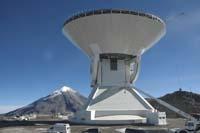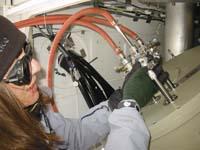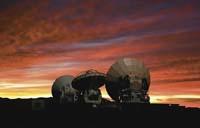From Mexico to the stars

The official inauguration took place in 2006. The chronicle of El Sol De Puebla highlighted that "President Fox was in charge of launching the mechanism of vision of the Virgo galaxy" and that "will have greater capacity of observation than the Hubble, Spitzer and Chandra of NASA". But it is not yet fully underway. Last touches: adjustments.
The name of this new Mexican telescope reveals two main characteristics: The Large Millimeter Telescope is, therefore, large and millimeter, that is, the millimeter. Contradiction? In no case. Because the millimeter does not refer to the size of the telescope, but to the wavelength it receives (they are basically radio waves). It is, therefore, a large telescope that works in millimeter waves. And to say the big is little: when they put it in place it will be the biggest telescope of this type.
Bilbaine Itziar Aretxaga is an astrophysicist at the Instituto Nacional de Astrofísica, Óptica y Electrónica de México INOE, with whom she works from the telescope's own project: "especially in scientific planning and dissemination". According to Aretxabaleta and his group's astrophysicists, "the stars radiate at least half the energy in millimeter and infrared waves."
From space comes to Earth a wide variety of radiations, mainly microwave, visible light, ultraviolet, infrared and millimeter. The least studied is millimetric radiation. So far, smaller telescopes have been used than TMH and only 0.01% of the sky has been investigated in millimeter waves. There is still much to do.
"According to the most accepted theory," says Aretxaga, "the stars are born surrounded by clouds of gas and dust, in an opaque environment. This means that the medium absorbs most of the wavelengths of the radiation, for example, we cannot see these sets of stars because the visual waves do not cross the cloud." Yes, however, because millimeter waves have a longer wavelength than the size of dust particles.

"Young galaxies emit millimeter waves capable of crossing the clouds." There is the question, according to Aretxaga: if you are able to look at millimeter waves, you can clearly see the formation of stars and galaxies.
Antxon Alberdi, astrophysicist at the Andalusian Institute of Astronomy of CSIC, is one of the researchers who will take advantage of TMH: "We will use it to investigate the presence of molecular gas in galaxies, that is, thanks to TMH we will be able to locate the large densities of molecular gas, the zones in which the stars are in constant formation".
Working with millimetric
The Large Millimeter Telescope is prepared to work between wavelengths of 0.85 mm and 4 mm. Thanks to its instrumentation and its 50-meter diameter plate, it will leave the rest of millimeter telescopes far behind in terms of resolution and speed.
The scientific director of the telescope is David Hughes. Hughes is clear that it is the "largest telescope of a plate optimized in millimeter waves", "the antenna of 50 meters of diameter is at the limit of what can be built with the current technology, considering that neither the precision of the surface of the plate can be lost, nor the precision with which the telescope moves and points".
One of the advantages of the Great Millimetric Telescope of Mexico is its location: It is located at a height of 4.600 meters in a very dry environment. According to Hughes, "being north at a latitude of 19 degrees, it will give good coverage of the sky of the northern and southern hemisphere." And to get an idea of the resolution you will have, use the following example: "The Large Millimeter Telescope will be able to see the width of a five-cent coin at one kilometer."

In addition to the resolution, one of the characteristics of the TMH is the speed, of which AzTEC cameras and other leading tools will be responsible. According to Aretxabaleta, "the main instrument is AZTEC, since we find astros that we do not know until now. It uses the technology of the yellow bolometers to detect radiation and is twenty times faster than the cameras of this type located in other telescopes."
With other telescope instruments, three-dimensional maps of the Milky Way and other nearby galaxies will be made, the sliding and chemical composition will be measured towards the red of distant galaxies, the color of the stars will be accurately measured. Therefore, it will be useful for the investigation of astrophysicists from various fields.
Within reach of the community
As for its use, the operation of the Large Millimeter Telescope is similar to that of other telescopes: the time limits of use are fixed by a committee of experts. The longer time is allocated to home researchers. Although the telescope is located in Mexico, the National Institute of Astrophysics, Optics and Electronics of Mexico has completed the project in collaboration with the Massachusetts Amherst University of the United States, so Mexican and American astrophysicists have priority. However, “once or twice a year, groups around the world will have the opportunity to submit proposals,” says Aretxaga, and the most interesting projects they present will also be able to use the telescope.
Each group is allowed to use a telescope tool within a given time. During this period of time, the collection and reception of the telescope data will be carried out, which will have time for its interpretation. According to the data obtained, a group may have a work of months, sometimes for a few years. "Science is not done on the telescope," explains Aretxaga, "in the office, but giving meaning to the data collected."
The researchers do not work on the telescope itself. Some rooms perform, especially in the first years of the telescope. But once the telescope works properly, the telescope will only operate a computer, in maintenance tasks, etc. The rest of the groups will be served by the possibilities of communication existing today for the collection of the data in their location.

In addition, a telescope located at the tip of a volcano is not the ideal place to work. It should be noted that at 4,600 meters, due to the lack of oxygen, discomfort can occur, especially in the first visit. To avoid risks, the telescope has a safety plan and Aretxaga has worked in the health surveillance systems of workers and visitors, who have received a training and have prepared the necessary resources in the field.
Pointing to the giant
When launched, one of the finest tasks is to point the telescope to the goal needed: to direct it to the chosen point in the sky. It should be taken into account that the telescope plate is enormously large and heavy and must be precisely pointed (in principle with the precision of a second arc). It is adapted to this mechanics of the telescope, but for a fine observation astrophysicists must know where the sky moves.
"The telescope is calibrated to know where it is oriented at all times, but in case it is necessary to ensure calibration for a couple of hours, moving from the observation source to the active nuclei of reference," says Aretxaga. Active nuclei are very visible points in the sky in millimeter waves (they are very luminous nuclei with some galaxies, such as quasars). According to the most accepted theory, it is the sign that there is a giant black hole, and the light is due to the fraction of matter surrounding the black hole). "They are not many, they will be a fabric and we use as a location reference the active cores close to the source object of observation".
They also use other reference sources. For example, to calibrate the light, to measure in physical units the light received by the telescope, that is, take as reference the highlights of the sky: the planets, among others. Logically, sky maps are also used as a reference. "We have as a model maps of other wavelengths, from X-ray maps to radio wave maps." In millimeter waves there is a very small part of the mapped sky, so one of the telescope's objectives will be the millimeter mapping of the sky. "Thus, we foresee that between one hundred billion new galaxies will become part of the census."
Antxon Alberdi noted that "it is necessary to make cartographies of different wavelengths, since each of them provides different information". And add: "The best way to investigate any astronomical object is to study it in many wavelengths, as they provide additional information."

"In millimeter waves there are currently enormous technological challenges. The great challenge of astronomy is to make increasingly sensitive instruments that detect increasingly weak radiation and are investing a lot of money in it," explains Alberdi. "In addition, TMH will work with another large facility: b) With the millimeter wave interferometric network being built in the Atacama Desert (Chile). It could be said that with TMH an analysis of the objects will be carried out and the details will be studied previously. But the previous analysis is very important, since it will tell us what objects can be investigated with CONCEPCIÓN".
ALMA will be the largest millimeter wave interferometer when it ends (for 2014). 50 telescopes will be placed in an area of ten kilometers of diameter with a plate of 12 meters each. And all these signals will be combined to form an interferometer. According to Hughes, "with this configuration, the ALMA telescope will have better resolution than the most spectacular image of the Hubble Space Telescope."
Hughes is proud of the position of the Great Millimeter Telescope in astrophysics: "Appropriate size and placed in a high and dry mountain, for the realization of extensive field maps, both in the local universe (within our galaxy) and in the distant universe; and with a resolution and sensitivity sufficient to observe in detail how are the physical processes that have governed their evolution throughout thirteen thousand seven hundred million years of universe history. And [referring to HYPERLINK], we can combine the information obtained with TMH with images of better angular resolution of millimeter wave interferometers to better understand the chemical and physical evolution of the universe in which we live.”

Buletina
Bidali zure helbide elektronikoa eta jaso asteroko buletina zure sarrera-ontzian











